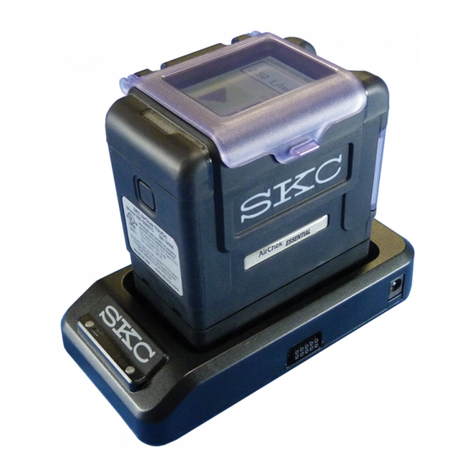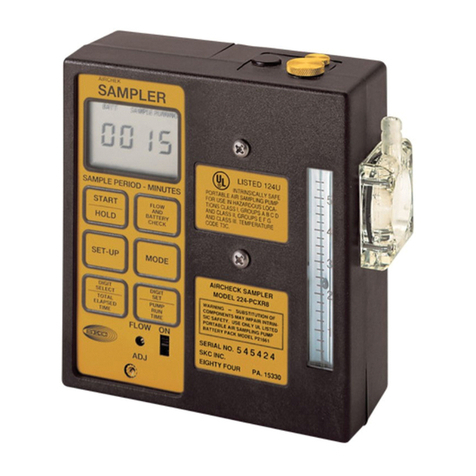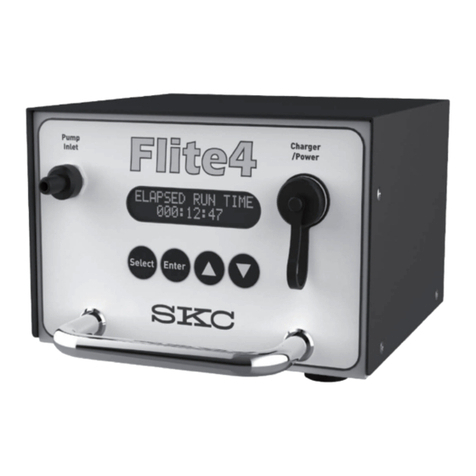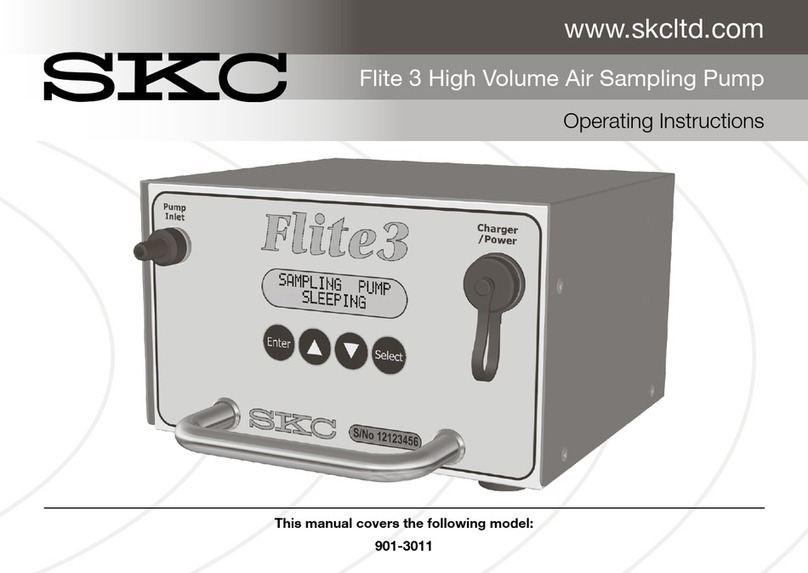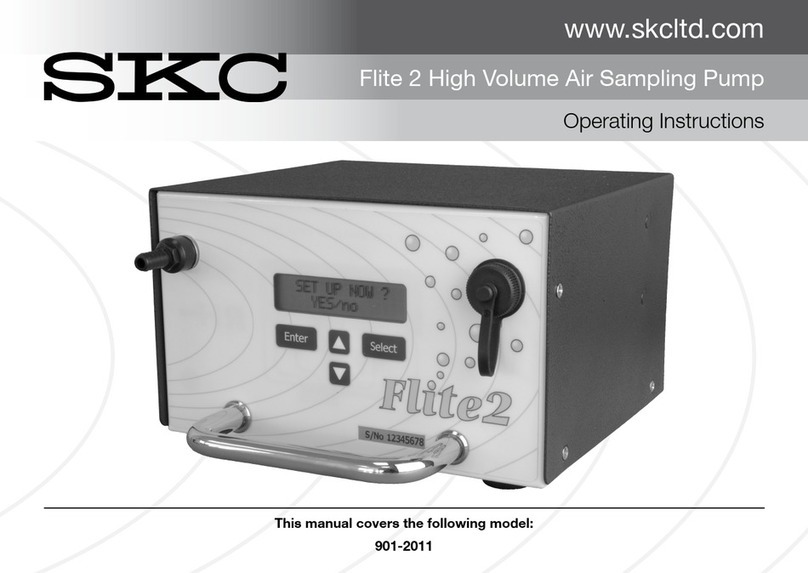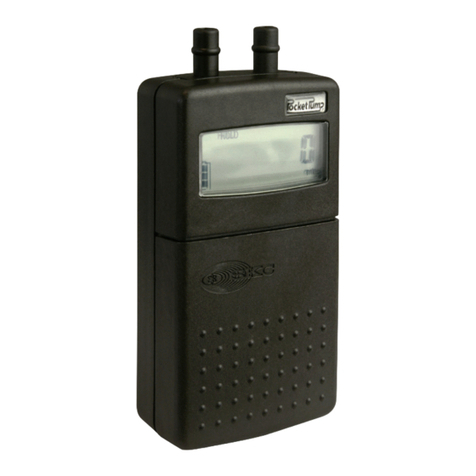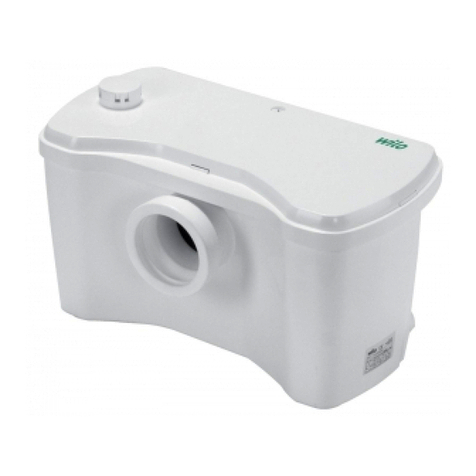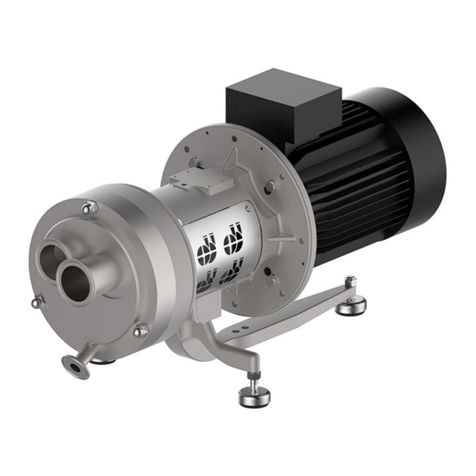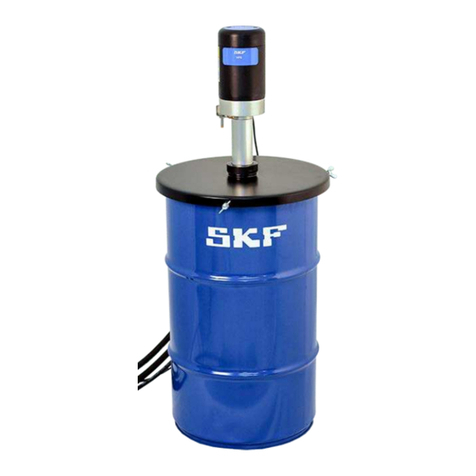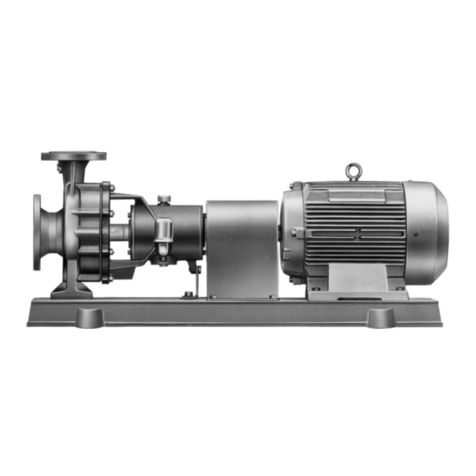SKC AirLite 110-100-T User manual

Form 37182 Rev 201019
Page 1 of 12
AirLite Sample Pump with Timer
Cat. No. 110-100-T
Operating Instructions
Figure 1. AirLite Sample Pump with Timer
863 Valley View Road, Eighty Four, PA 15330 USA • Tel: 724-941-9701 • www.skcinc.com
Accessory
mounting
screws
Protective
control cover
(raised)
Belt clip (back of pump)
Battery compartment
Pump inlet
(inlet filter
underneath)
Bottom view
Top view
Battery compartment door
Flow
adjustment
screw
On/off
button
Battery
compartment
screw
Hinge
Introduction
Description
The AirLite Sample Pump with Timer (Figure 1) provides 5 to 3000 ml/min flows and is suitable for abatement, indoor air sampling,
and emergency response in non-hazardous locations.
Checking Pump/Kit Contents
Use the table below to verify that you received all items associated with the Cat. No. ordered. If you are missing items, contact
SKC at 800-752-8472 (U.S. only) or 724-941-9701.
If You Ordered Cat. No. Your Package Should Contain
110-100-T AirLite Sample Pump with Timer only, with three AA alkaline batteries and screwdriver set
110-100-TK5 High Flow Sample Pump Kit includes 5 pumps as described above and filter cassette holders, in a Pelican case
110-100-TK5D High/Low Flow Sample Pump Kit includes 5 pumps as described above, filter cassette holders, All-in-One adjustable
tube holders, and Type A protective tube covers, in a Pelican case
Required Equipment
1/4-inch ID tubing
Low flow accessories if sampling at 5 to 500 ml/min. See Accessories.
Front view
LCD

Form 37182 Rev 201019
Page 2 of 12
Getting Started
Insert/Replace the Batteries
The AirLite with Timer is powered by three standard AA alkaline batteries located in a compartment on the bottom of the pump
(Figure 1). To insert new or replace existing batteries:
1. Use a slotted screwdriver to loosen the screw on the bottom of the case (Figure 1).
2. Open and remove the compartment door.
3. If replacing existing batteries, remove them. Insert new batteries.
Note the polarity of the batteries. See right.
4. With the new batteries in place, insert the hinge (Figure 1) on the compartment door under the lip of the case, close the door, and
tighten the screw until secure.
Notes and Cautions
• Do not operate AirLite with Timer in hazardous or explosive locations. AirLite with Timer is designed for applications that do not require intrinsic
safety.
• Failure to follow warnings or cautions voids any warranty.
• For maximum run time, insert new batteries in pump before each sampling period. If using rechargeable AA 1.2-volt NiMH batteries, expect
approximately half the run time stated for disposable batteries.
• To prevent corrosion of battery terminals, remove batteries when AirLite with Timer will not be used for an extended time.
• Increases in back pressure in sampling condition due to buildup on filter can decrease battery life.
Hinge
Polarity of batteries
Screw
+
+
-
-
-
+

Form 37182 Rev 201019
Page 3 of 12
Operation
High Flow Applications (1000 to 3000 ml/min)
Set/Calibrate Flow Rate
Do not operate pump in hazardous or explosive locations. AirLite with Timer is designed for applications that do not require intrinsic
safety.
• Allow pump to equilibrate after moving it from one temperature extreme to another.
1. Turn on the pump using the on/off button (Figure 1) and run for 5 minutes before calibrating. Leave the pump running.
2. Prepare the calibrator. See calibrator instructions.
3. Set up a calibration train (see below): Using flexible tubing, connect the calibrator outlet (suction port) to the representative sample
medium inlet. Using 1/4-inch ID tubing, connect the representative sampling medium outlet to the pump inlet.
4. Using a small screwdriver, set the pump flow rate by turning the flow adjustment screw (Figure 1) clockwise to increase the flow
or counterclockwise to decrease the flow until the calibrator indicates the method-specified flow rate. Take a minimum of three
readings and record the average flow rate, as per OSHA/NIOSH instructions.
5. Press the on/off button to turn off the pump. Disconnect the calibrator and flexible tubing from the representative sample medium
and proceed to Set Up/Sample.
Tygon tubing
Representative sample medium
chek-mate
Calibrator
Pump inlet
Calibration train with filter cassette
Suction port

Form 37182 Rev 201019
Page 4 of 12
Set Up/Sample
• Allow pump to equilibrate after moving it from one temperature extreme to another.
• Protect sample pump from weather when sampling outdoors.
• Do not operate the pump in hazardous or explosive locations. AirLite with Timer is designed for applications that do
not require intrinsic safety.
• For maximum run time, insert new batteries in pump before each sampling period. If using rechargeable AA 1.2-volt
NiMH batteries, expect approximately half the run time stated for disposable batteries.
1. Replace the representative sample medium used for calibration with new unexposed medium for sample
collection.
2. Place the sample medium where appropriate for sampling. For personal sampling, clip the sample collection
medium to the worker in the breathing zone and the pump to the worker’s belt using the belt clip.
3. Press the on/off button to turn on the pump and start sampling. Record the start time and other pertinent
information. The LCD will automatically display elapsed pump run time. See below.
Possible Displays During Sampling
Flow or Battery Fault Shutdown - If the pump is unable to compensate due to excessive back pressure or a low battery
condition exists, it will shut down and timing functions will pause. The LCD will display either a battery-shaped icon
or a flow fault icon () depending on the cause of the shutdown. Upon flow fault, the pump will attempt to restart up
to five times. To restart from flow fault, correct the blockage and press the on/off button twice. The elapsed run time
display will reset to 0 when the pump is restarted. If the battery icon is displayed, recharge the battery before sampling.
Displayed Elapsed Run Time - Elapsed run time is displayed continuously on the LCD. For elapsed times after 999
minutes, the display will show the count start from 0 to 999 again.
4. At the end of the sampling period, press the on/off button and record stop time and other pertinent information.
5. Cap the sample and send it with blanks and pertinent sampling information to a laboratory for analysis.
6. Verify the flow.
a. Turn on the pump and reinstate the calibration train and sample medium.
b. Take three readings and record the average value as the post-sample flow rate. Do not adjust the pump flow rate during this step.
c. Compare the pre and post-sample flow rates. Note in sampling documentation if the values differ by more than ± 5%.
Clip sample medium
to worker and pump
to belt.

Form 37182 Rev 201019
Page 5 of 12
Low Flow Applications (5 to 500 ml/min)
• Single-tube sampling requires the All-in-One Adjustable Tube Holder; see the operating instructions for the All-in-One for details on its operation.
• Multiple-tube sampling requires a Constant Pressure Controller (CPC) and a Dual, Tri, or Quad Adjustable Low Flow Tube Holder accessory;
see the operating instructions for the CPC and Adjustable Low Flow Tube Holder for details on their operation.
Using the All-in-One Adjustable Tube Holder
Set/Calibrate Flow Rate for Single Tube
Do not operate AirLite with Timer in hazardous or explosive locations. Pump is designed for applications that do not require intrinsic
safety.
• Allow pump to equilibrate after moving it from one temperature extreme to another.
• Calibrate/verify pump flow rate before and after each sampling operation using the tube holder and pump to be used for sampling.
• Set the flow rate through the pump first and then calibrate the flow rate through the representative sorbent tube.
• Two small inlet holes on the bottom of the built-in CPC of the All-in-One can become blocked. Periodically inspect and, if needed, clean with a
small pick and blow particles away with a puff of air.
Pump Flow Rate
1. Turn on the pump using the on/off button (Figure 1) and run for 5 minutes
before calibrating. Leave the pump running.
2. Prepare the calibrator (see calibrator instructions). Using flexible tubing,
connect the calibrator outlet (suction port) to the pump inlet.
3. Set the pump flow rate to 1.5 L/min. Using a small screwdriver, turn the
flow adjustment screw on top of the pump (Figure 1), clockwise to increase
flow or counterclockwise to decrease flow, until the calibrator indicates
1.5 L/min.
4. Remove tubing from the pump inlet.
Flow Rate Through Sorbent Tube
1. Attach the Tygon tubing of the All-in-One to the pump inlet. See calibration
train at right. Note: If the pump flow faults shortly after the holder is attached,
check that the needle valve is open by using a small flat-head screwdriver to
turn the flow adjust screw on the holder slightly counterclockwise. If flow fault
continues, check that the two small holes on the bottom of the built-in CPC are
not blocked. If needed, clean holes with a small pick and blow any particles away with a puff of air.
2. Break tips off the representative sorbent tube and insert it into the rubber sleeve on the All-in-One (arrow on the tube points toward
the holder). Ensure that the sorbent tube fits snugly in the rubber sleeve prior to sampling to avoid air leakage. Two sleeves, each a
different inner diameter, are supplied with the All-in-One.
3. Using flexible tubing, connect the calibrator outlet to the inlet of the representative sorbent tube in the holder.
In the next step, do not shut off flow completely with flow adjust screw or use an oversize screwdriver to adjust
flow — valve or thread seat damage may result.
4. Do not adjust the flow on the pump. Adjust the flow rate through the representative sorbent tube using a
small flat-head screwdriver to turn the flow adjust screw on the All-in-One (counterclockwise to increase,
clockwise to decrease) until the calibrator displays the method-specified flow rate. Take a minimum of three
readings and record the average flow rate, as per OSHA/NIOSH instructions.
5. When calibration is complete, turn off the pump by pressing the on/off button. Disconnect the calibrator and tubing from the representative
sorbent tube inlet.
Flow adjust screw
(needle valve)
All-in-One
adjustable
tube holder
Tygon tubing
Pump
inlet
Turn screw on holder
to adjust flow.
Flow
adjust
screw
Calibration train with All-in-One
connected to pump
Suction
port

Form 37182 Rev 201019
Page 6 of 12
Set Up/Sample with Single Tube
Do not operate AirLite with Timer in hazardous or explosive locations. Pump is designed for applications that do not require intrinsic safety.
• For maximum run time insert new batteries in pump before each sampling period. If using rechargeable AA 1.2-volt NiMH batteries, expect
approximately half the run time stated for disposable batteries.
• Allow pump to equilibrate after moving it from one temperature extreme to another.
• Protect sample pump from weather when sampling outdoors.
• Calibrate/verify pump flow rate before and after each sampling operation using the tube holder and pump to be used for
sampling.
1. Replace the representative sorbent tube used for calibrating flow with a new unexposed sorbent tube for sample
collection. Note: Ensure sorbent tube fits snugly in rubber sleeve of the All-in-One before sampling to avoid any air
leakage. Two sleeves, each a different inner diameter (ID), are supplied. See Figure 2.
2. Place the protective tube cover over the sorbent tube and thread it into place on the All-in-One until secure.
3. Place the sorbent tube where appropriate for sampling. For personal sampling, clip the sample medium to the
worker in the breathing zone and the pump to the worker’s belt.
4. Press the on/off button to turn on the pump and start sampling. Record the start time and other pertinent
information.
Possible Displays During Sampling
Flow or Battery Fault Shutdown - If the pump is unable to compensate due to excessive back pressure or a low battery
condition exists, it will shut down and timing functions will pause. The LCD will display either a battery-shaped icon
or a flow fault icon () depending on the cause of the shutdown. Upon flow fault, the pump will attempt to restart up
to five times. To restart from flow fault, correct the blockage and press the on/off button twice. The elapsed run time
display will reset to 0 when the pump is restarted. If the battery icon is displayed, recharge the battery before sampling.
Displayed Elapsed Run Time - Elapsed run time is displayed continuously on the LCD. For elapsed times after 999
minutes, the display will show the count start from 0 to 999 again.
5. At the end of the sampling period, press the on/off button and record stop time and other pertinent information.
6. Cap the sample tube and send it with blanks and pertinent sampling information to a laboratory for analysis.
7. Verify the flow.
a. Turn on the pump and reinstate the calibration train and sample media.
b. Take three readings and record the average value as the post-sample flow rate. Do not adjust the pump flow rate during this step.
c. Compare the pre and post-sample flow rates. Note in sampling documentation if the values differ by more than ± 5%.
Clip tube holder to
worker and pump
to belt.
Figure 2. All-in-One Adjustable Tube Holder Connected to pump
Flow adjust screw
(needle valve)
Threaded fitting All-in-One rubber sleeve
Built-in CPC
Tygon tubing
Pump
inlet

Form 37182 Rev 201019
Page 7 of 12
Using a CPC and Dual, Tri, or Quad Adjustable Low Flow Tube Holder (Figure 3)
Set/Calibrate Flow Rate for Multiple Tubes
Do not operate pump in hazardous or explosive locations. Pump is designed for applications that do not require intrinsic safety.
• Requires Constant Pressure Controller (CPC) and Adjustable Low Flow Tube Holder (see Accessories). The low flow tube holder used with CPC
allows up to four tube samples to be taken simultaneously, each at different flow rates if desired.
• Allow pump to equilibrate after moving it from one temperature extreme to another.
• Calibrate/verify pump flow rate before and after each sampling operation using the tube holder and pump to be used for sampling.
• Set the flow rate through the pump first and then calibrate the flow rate through each sorbent tube.
Pump Flow Rate
Follow these important steps before proceeding.
1. Ensure that the battery is fully charged and that the pump has run for 5 minutes before calibrating. Leave pump running.
2. Prepare a calibrator (see calibrator instructions). Using flexible tubing, connect the calibrator outlet (suction port) to the pump inlet.
3. Calculate the sum of all tube flow rates. The maximum flow rate through any one tube is 500 ml/min.*
a.Ifthesumis≤1000ml/min,setthepumpflowrateto1.5L/min.
b. If the sum is > 1000 ml/min, multiply that number by 0.15 and total the two numbers. Set the pump flow rate for the resulting
new sum. (Example: Sampling with three sorbent tubes, each with a flow rate of 500 ml/min.* The sum of the tube flow rates is
calculated as 3 x 500 = 1500. Determining a 15% higher flow rate is calculated as 1500 x 0.15 = 225. Calculating the final pump
flow setting would be 1500 + 225 = 1725 ml/min.)
* Back pressure across some sample tubes can be higher than average. In these instances, the maximum flow rate of 500 ml/min per tube may not
be achieved.
4. Using a small screwdriver, turn the flow adjustment screw on top of the pump (Figure 1), clockwise to increase or counterclockwise
to decrease flow, until the calibrator indicates the required flow rate.
5. Remove tubing from the pump inlet and calibrator outlet.
Flow Rate Through Sorbent Tubes
1. Attach the tubing on the CPC outlet (side of the CPC without a label) to the pump inlet. Attach the Adjustable Low Flow Holder to
the CPC inlet (marked “To Sample”). See Figure 4.
2. Break tips off the representative sorbent tubes and insert them into the rubber sleeves on the holder (arrow on each tube pointing
toward pump). Place unopened tubes in any unused ports to “seal” them.
3. Label all representative sorbent tubes and ports.
4. Using flexible tubing, connect the exposed end of the first representative tube to the calibrator outlet (suction port).
Figure 3. Quad Adjustable Low Flow Tube Holder
Top view of flow
adjust screws
Anti-tamper cover
Low flow holder outlet
Sorbent sample tube
Rubber sleeve
Clothing clip
Flow adjust screws
Protective cover

Form 37182 Rev 201019
Page 8 of 12
5. Using a small screwdriver, loosen and turn the brass flow adjust screw (see above right) directly
beneath the port holding the first active representative tube to be calibrated (clockwise to increase,
counterclockwise to decrease) until the calibrator indicates the method-specified flow rate. Do
not adjust the flow rate on the pump. Note: For tri and quad models, first rotate each anti-tamper
cover to expose the flow adjust screws, then adjust the appropriate one until the calibrator indicates the
desired flow (Figures 3 and 5).
6. Repeat Steps 4 and 5 for each active representative tube. Note: Changing the flow on one tube will
not affect the flow rate through the remaining tubes.
7. Once flow is calibrated for each active representative tube, it is recommended practice to re-check
the flow rate through all representative tubes before removing them. Any adjustment should be
minimal.
Set Up/Sample with Multiple Tubes
Do not operate AirLite with Timer in hazardous or explosive locations. Pump is designed for applications that do not require intrinsic safety.
• Requires Constant Pressure Controller (CPC) and Adjustable Low Flow Tube Holder (see Accessories). The low flow tube holder used with CPC
allows up to four tube samples to be taken simultaneously, each at different flow rates if desired.
• Allow pump to equilibrate after moving it from one temperature extreme to another.
• Protect sample pump from weather when sampling outdoors.
• For maximum run time, insert new batteries before each sampling period. If using rechargeable AA 1.2-volt
batteries, expect approximately half the run time stated for disposable batteries.
• The two small inlet ports on the bottom of the CPC can become blocked. Inspect these ports periodically for
blockage that can occur when sampling in dusty environments. Such blockage may cause back pressure to
increase. Clean ports with a small pick and blow away any particles with a puff of air.
1. Replace the representative sorbent tubes used for calibration with new unexposed sorbent tubes for
sample collection.
2. Place a protective tube cover over each tube and thread into place on holder until secure.
3. Place the adjustable holder with tubes where appropriate for sampling. For personal sampling, clip the
low flow tube holder to the worker in the breathing zone and the pump to the worker’s belt. See right.
4. Press the on/off button to turn on the pump and start sampling. Record the start time and other pertinent
information.
Possible Displays During Sampling
Flow or Battery Fault Shutdown - If the pump is unable to compensate due to excessive back pressure or a low battery
condition exists, it will shut down and timing functions will pause. The LCD will display either a battery-shaped icon
or a flow fault icon () depending on the cause of the shutdown. Upon flow fault, the pump will attempt to restart up
to five times. To restart from flow fault, correct the blockage and press the on/off button twice. The elapsed run time
display will reset to 0 when the pump is restarted. If the battery icon is displayed, recharge the battery before sampling.
Displayed Elapsed Run Time - Elapsed run time is displayed continuously on the LCD. For elapsed times after 999
minutes, the display will show the count start from 0 to 999 again.
Connect
CPC to
pump inlet,
tube holder
to CPC, and
tube inlet to
calibrator.
Figure 4. Calibration Train with Quad Adjustable
Low Flow Tube Holder
Suction port
chek-mate Calibrator
Quad tube holder
Tube holder outlet
Pump
inlet
CPC inlet (marked
“To Sample”)
Screw Screw
Figure 5. Cut-away of Tri/
Quad Adjustable Low Flow
Tube Holder
Turn screw on tube holder to
adjust flow.
Flow adjust screws
Clip tube holder to
worker and pump
to belt.

Form 37182 Rev 201019
Page 9 of 12
5. At the end of the sampling period, press the on/off button and record stop time and other pertinent information.
6. Cap the sample tubes and send with blanks and pertinent sampling information to a laboratory for analysis.
7. Verify the flow.
a. Turn on the pump and reinstate the calibration train and sample media.
b. Take three readings and record the average value as the post-sample flow rate. Do not adjust the pump flow rate during this step.
c. Compare the pre and post-sample flow rates. Note in sampling documentation if the values differ by more than ± 5%.
Maintenance
See Insert/Replace the Batteries.
Pump Service
Pumps under warranty should be sent to SKC Inc. for servicing. See Limited Warranty and Return Policy.

Form 37182 Rev 201019
Page 10 of 12
Accessories/Replacement Parts
Accessories Cat. No.
chek-mate Calibrator with CalChek, 0.50 to 5 L/min, includes 9-volt alkaline battery and
NIST-traceable certificate 375-0550N
Low Flow Sampling Accessories
Low Flow Adapter Kit includes an All-in-One adjustable tube holder and Type A Protective Tube Cover 110-500
Constant Pressure Controller, required for adjustable low flow holders below 224-26-CPC
Dual Adjustable Low Flow Tube Holder 224-26-02
Tri Adjustable Low Flow Tube Holder 224-26-03
Quad Adjustable Low Flow Tube Holder 224-26-04
Protective Cover for Sorbent Tubes
Type A - 6-mm OD x 70-mm L, included in Low Flow Adapter Kit above 224-29A
Type B - 8-mm OD x 110-mm L 224-29B
Type C - 10-mm OD x 150-mm L 224-29C
Type D - 10-mm OD x 220-mm L 224-29D
Miscellaneous
Screwdriver Set (included with pump) 224-11
Protective Nylon Pouch with belt loop, black 224-902
Waist Strap 224-12
Replacement Parts Cat. No.
1 Stack screws P51891
2 Inlet hose connector P20106
3 Pulsation dampener P2010802
4 Stack plate N/A
5 Valve plates (top and bottom) P213201
6 Diaphragm/Yoke assembly P22417HC
7 Pump body P22417G
8 Motor/Eccentric P51890
9 Pump base P20182
Battery case cover (not shown) P20184
1
5
1
4
9
2
6
8
7
3
5
SKC Limited Warranty and Return Policy
SKC products are subject to the SKC Limited Warranty and Return Policy, which provides SKC’s sole liability and the buyer’s exclusive remedy.
To view the complete SKC Limited Warranty and Return Policy, go to http://www.skcinc.com/warranty.

Form 37182 Rev 201019
Page 11 of 12
Appendix
Performance Profile
Flow Range 1000 to 3000 ml/min (5 to 500 ml/min requires low flow accessories. See Accessories.)
Flow Control Patented* system holds constant flow to ± 5% of set-point
Compensation Range
(for a minimum of 8-hour
operation)
1000 ml/min at 30 inches water back pressure
2000 ml/min at 20 inches water back pressure
3000 ml/min at 10 inches water back pressure
Typical back pressure of
sampling media
(inches water)
Flow Rate (L/min) 1.0 1.5 2.0 2.5 3.0
Filter/Pore Size (µm)
25-mm MCE/0.8 6 9 12 15 —
25-mm MCE/0.45 14 22 — 35 —
37-mm MCE/0.8 2 3 4 5 6
37-mm PVC/5.0 1 1 2 2 2.5
Compare the information in this table to pump compensation range to determine appropriate applications.
Temperature Ranges Operating: 32 to 104 F (0 to 40 C)
Storage: -4 to 113 F (-20 to 45 C)
Compensated Temperature
Range
41 to 122 F (5 to 50 C)
Operating Humidity 0 to 95% non-condensing
Power Three standard AA alkaline batteries
Rechargeable AA size 1.2-volt NiMH batteries may be used but will provide approximately
half the run time stated for disposable batteries.
Tubing Requires 1/4-inch ID tubing
Case/Material Plastic, RFI/EMI-shielded
Certifications CE marked
Battery Run Time Depends on batteries used. See Table 1.
Intrinsic Safety Do not operate AirLite with Timer in hazardous or explosive locations. AirLite is designed for
applications that do not require intrinsic safety.
Dimensions 4.6 x 3 x 1.75 in (11.7 x 7.6 x 4.4 cm)
Weight (including batteries) 12 oz (340 grams)
* U.S. Patent No. 6,741,056

Form 37182 Rev 201019
Page 12 of 12
Table 1. Pump Run Time in Hours with Alkaline Batteries
• To prevent corrosion of battery terminals, remove batteries when AirLite with Timer will not be used for an extended time.
• Increases in back pressure in sampling condition due to buildup on filter can decrease battery life.
• For maximum run time, insert new batteries in pump before sampling.
• If using rechargeable AA 1.2-volt NiMH batteries, run time will be approximately half that stated for disposable batteries.
Following are typical run times achieved when using a new pump and new disposable AA alkaline batteries. Data is sorted by type of
sample media. All run times are listed in hours. Pump and battery performance may vary.
Mixed Cellulose (MCE) Filter, 0.8-µm pore size
Filter Diameter 37 mm 37 mm 37 mm 25 mm 25 mm
Flow Rate 1 L/min 2 L/min 2.5 L/min 1 L/min 2 L/min
Duracell®Standard 23.5 14.5 13.5 18.5 10.5
Rayovac®Maximum 20.0 16.5 14.0 16.5 11.0
Wal-Mart EverActive 24.0 16.0 10.5 18.0 10.5
Eveready Alkaline 20.0 14.0 13.0 17.0
Not tested
Polyvinyl Chloride (PVC) Filter, 5.0-µm pore size
Filter Diameter 37 mm 37 mm 37 mm 25 mm 25 mm
Flow Rate 1 L/min 2 L/min 2.5 L/min 1 L/min 2 L/min
Duracell Standard 23.5 15.5 17.0 23.0 10.5
Rayovac Maximum 29.5 16.5 14.0 18.5 13.0
Wal-Mart EverActive 24.5 20.5 15.5 20.5 11.5
Glass Fiber Filter
Filter Diameter 37 mm 37 mm 37 mm 37 mm
Flow Rate 1 L/min 2 L/min 2.5 L/min 3 L/min
Energizer 29.5 18.0 21.0 18.5
Rayovac Maximum 26.5 23.5 23.0 14.0
Wal-Mart EverActive 33.5 24.5 17.5 19.0
Filter Diameter 25 mm 25 mm 25 mm 25 mm
Flow Rate 1 L/min 2 L/min 2.5 L/min 3 L/min
Energizer 29.0 18.5 18.5 12.0
Rayovac Maximum 9.5 19.5 14.5 13.5
Wal-Mart EverActive 26.0 20.0 14.5 14.0
Table of contents
Other SKC Water Pump manuals
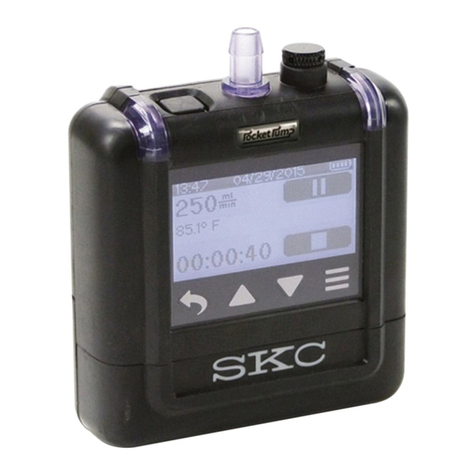
SKC
SKC TOUCH Operating instructions
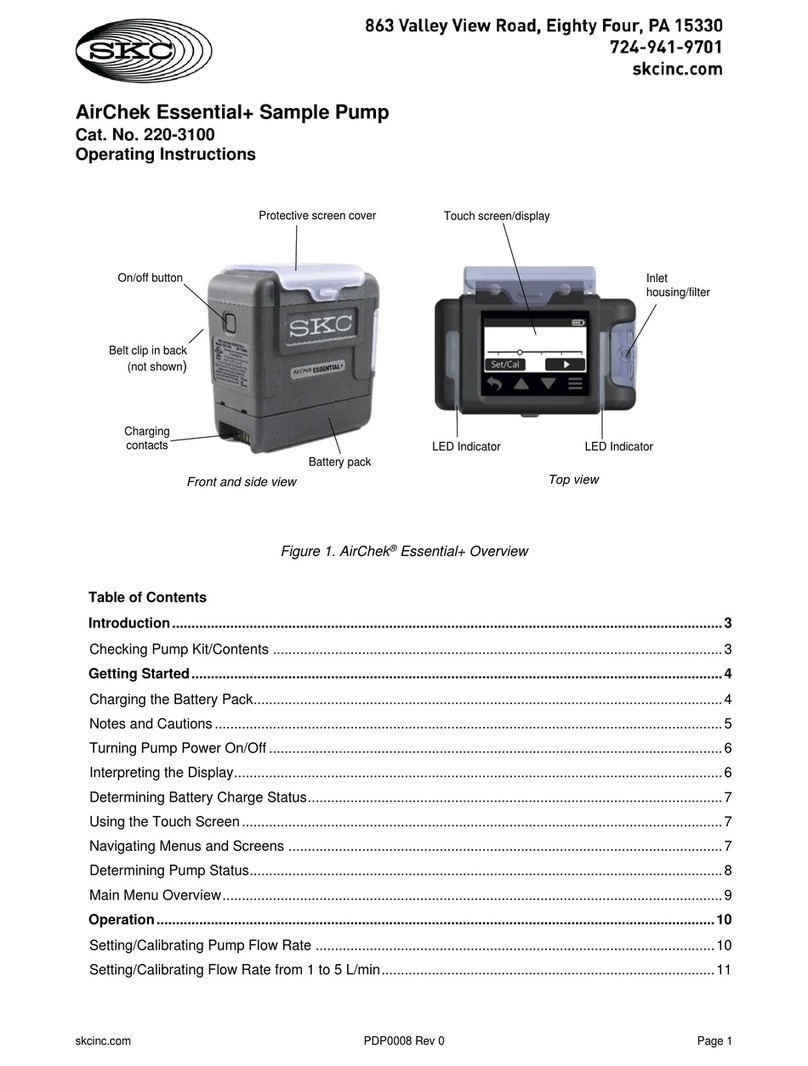
SKC
SKC AirChek 220-3100 User manual
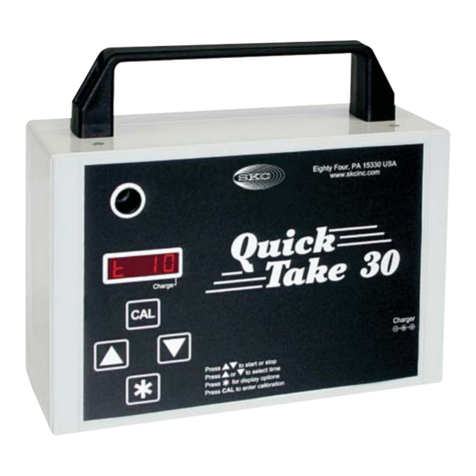
SKC
SKC QuickTake 30 User manual

SKC
SKC AirChek2000 User manual

SKC
SKC Quick Take 15 User manual
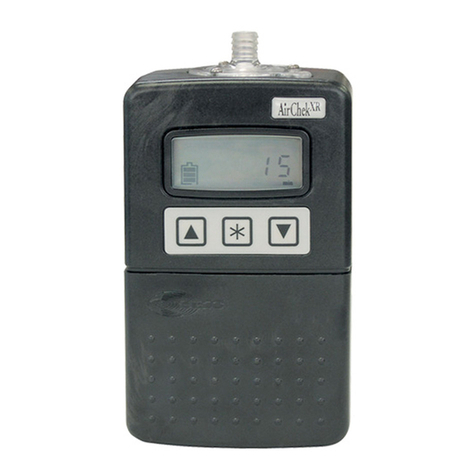
SKC
SKC AirChek XR5000 User manual
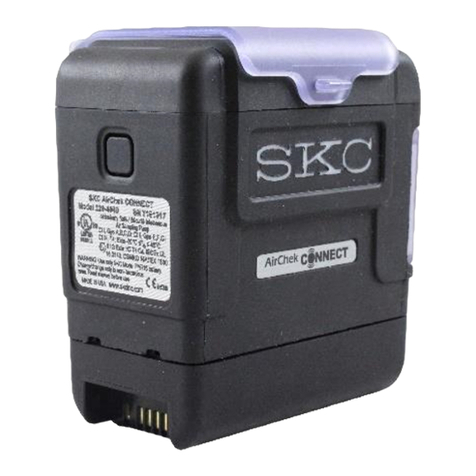
SKC
SKC AirChek Connect User manual

SKC
SKC 224-PCMTX8 User manual

SKC
SKC AirChek XR5000 User manual

SKC
SKC Leland Legacy User manual
Popular Water Pump manuals by other brands

GORMAN-RUPP PUMPS
GORMAN-RUPP PUMPS D Series Installation, operation, and maintenance manual with parts list
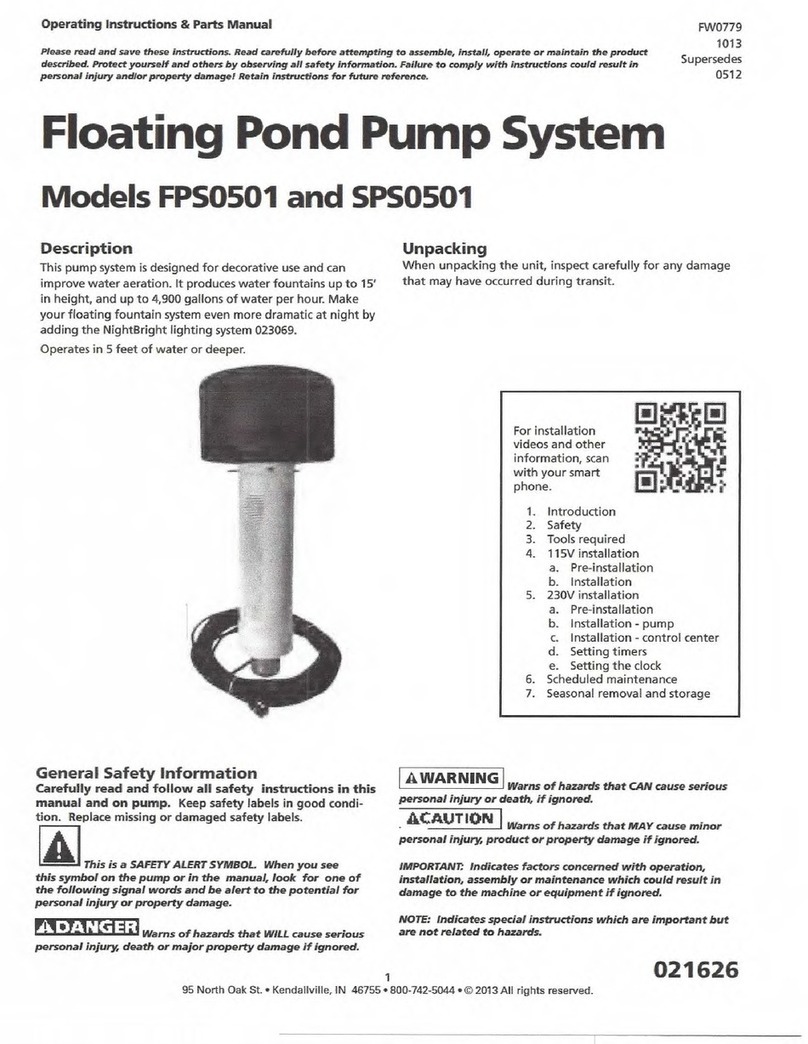
Flint & Walling
Flint & Walling FPS0501 operating instructions
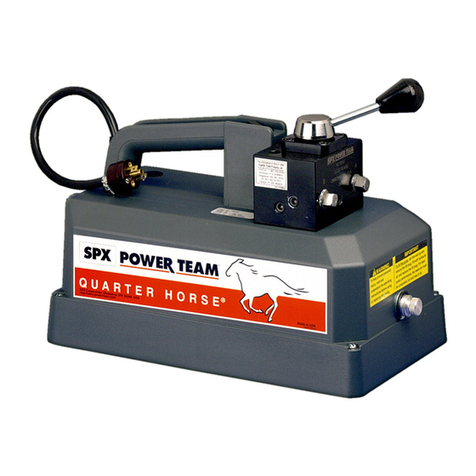
Power Team
Power Team PE10 Series operating instructions
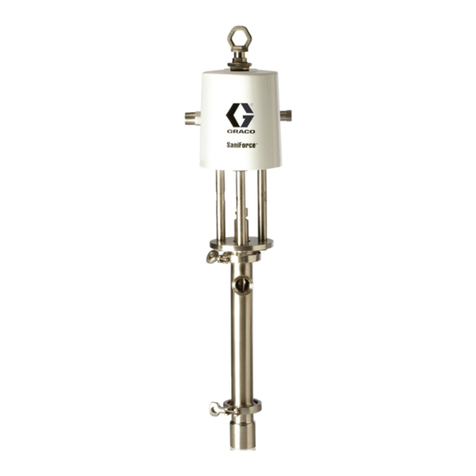
Graco
Graco SaniForce 24E836 Instructions and parts

Rietschle
Rietschle VCAH 100 operating instructions
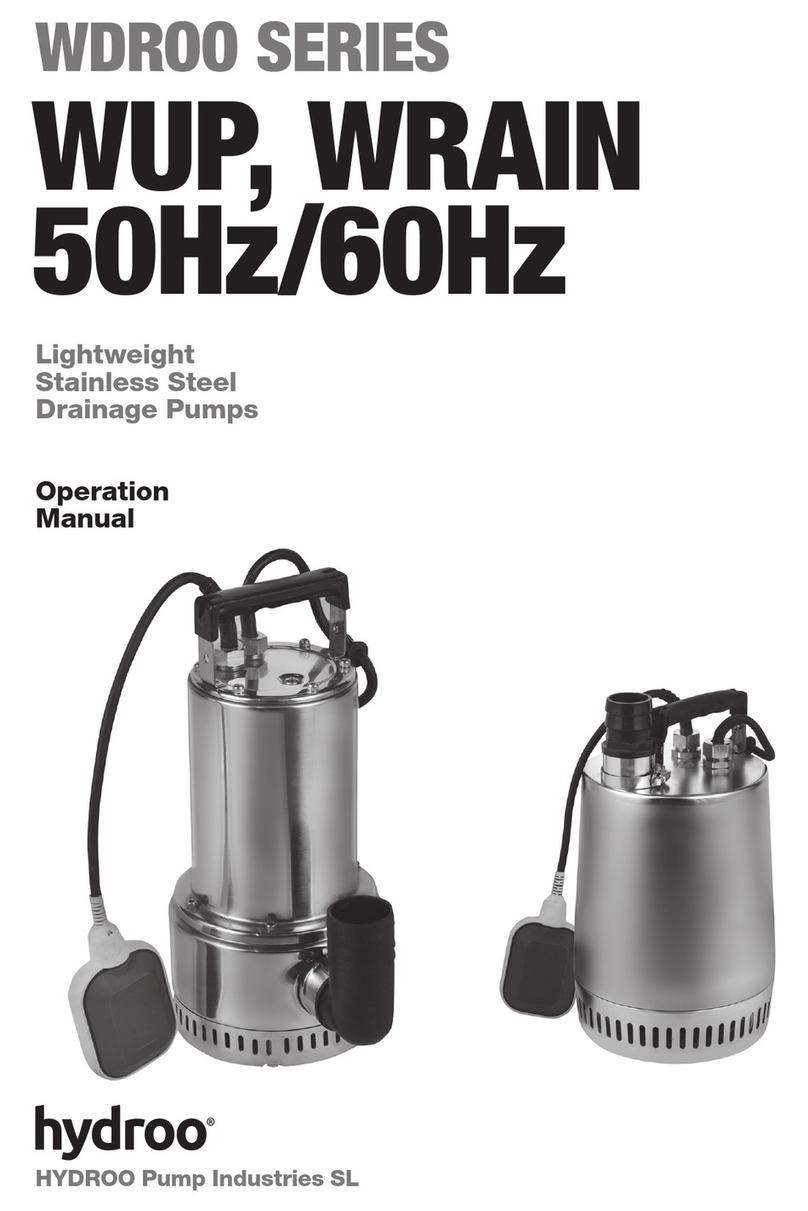
HYDROO
HYDROO WDROO Series Operation manual
